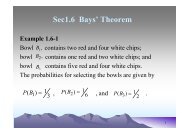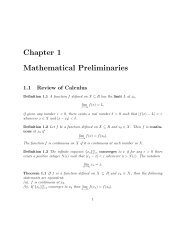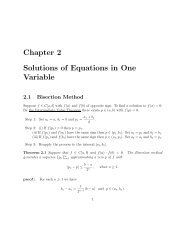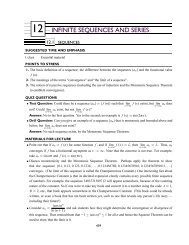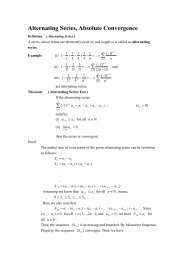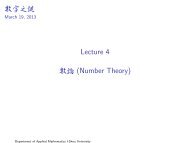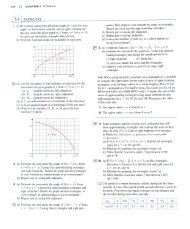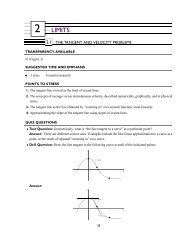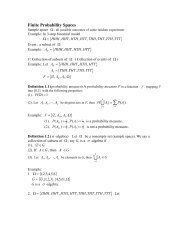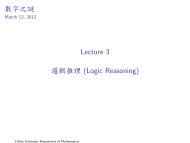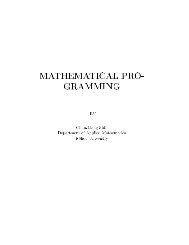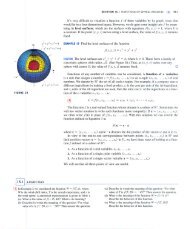9 FURTHER APPLICATIONS OF INTEGRATION
9 FURTHER APPLICATIONS OF INTEGRATION
9 FURTHER APPLICATIONS OF INTEGRATION
You also want an ePaper? Increase the reach of your titles
YUMPU automatically turns print PDFs into web optimized ePapers that Google loves.
CHAPTER 9<br />
SAMPLE EXAM SOLUTIONS<br />
3.<br />
(c) Substitute u = cos x. Thendu =−sin xdx,so<br />
S = − ∫ √<br />
−1<br />
1<br />
2π 1 + u 2 du = 2π ∫ √<br />
1<br />
−1<br />
1 + u 2 du<br />
[ √<br />
= 2π u 1 + u 2 + ln<br />
y<br />
1<br />
0<br />
y=Ïx<br />
R<br />
LÁ<br />
y=x@<br />
Lª<br />
1 x<br />
( √ )] 1<br />
u 1 + u 2 = 2√ 2π + π ln<br />
−1<br />
P = L 1 + L 2 =<br />
∫ 1<br />
0<br />
√<br />
1 +<br />
( 1<br />
2 √ x<br />
( √ )<br />
√ 2+1<br />
2−1<br />
) 2 ∫ 1 √<br />
dx + 1 + (2x) 2 dx<br />
4. (a) The area enclosed by an equatorial circle is πR 2 . A sphere of radius R is formed by rotating the curve<br />
y = √ R 2 − x 2 about the x-axis.<br />
(b) The surface area is S =<br />
(c)<br />
∫ R<br />
−R<br />
∫ R<br />
−R<br />
∫ R<br />
−R<br />
2π √ ( )<br />
R 2 − x<br />
√1 2 −x 2<br />
+ √ dx, so the claim means that<br />
R 2 − x 2<br />
2π √ ( )<br />
R 2 − x<br />
√1 2 −x 2<br />
+ √ dx = 4πR 2 .<br />
R 2 − x 2<br />
2π √ ( )<br />
R 2 − x<br />
√1 2 −x 2<br />
+ √ dx =<br />
R 2 − x 2<br />
∫ R<br />
−R<br />
2π √ R 2 − x 2 √<br />
R 2<br />
R 2 − x 2 dx<br />
= ∫ R<br />
−R2πRdx = 4πR2<br />
5. (a) The arc length L = ∫ √<br />
4<br />
0<br />
1 + [ f ′ (x) ] 2 dx,sosince2≤ f ′ (x) ≤ 4, we can say that 4 √ 5 ≤ L ≤<br />
4 √ 17.<br />
(b) Here L = ∫ 4<br />
0<br />
√1 + [ g ′ (x) ] √<br />
2 dx ≥ 4, since 1 + [ g ′ (x) ] 2 ≥ 1forallx.<br />
(c) The surface area S = ∫ 4<br />
0<br />
√1 2π f (x) + [ f ′ (x) ] 2 dx,sosince1≤ f (x) ≤ 3and−1 ≤ f ′ (x) ≤ 1<br />
on the interval [0, 4], we can say 8π ≤ S ≤ 24 √ 2π.<br />
6. (a) L = ∫ √<br />
( )<br />
1<br />
2<br />
0<br />
1 + 13<br />
x −2/3 dx<br />
(b) The integral is improper because lim<br />
interval of integration.<br />
x→0 + √<br />
1 +<br />
(<br />
13<br />
x −2/3 ) 2<br />
=∞. The integrand is unbounded on the<br />
(c) Wecanseefromagraphof f (x) = 3√ x that the curve has finite length; therefore, the integral must<br />
converge.<br />
521<br />
0



